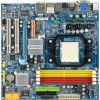- Qualcomm Launches Snapdragon 4 Gen 2 Mobile Platform
- AMD Launches Ryzen PRO 7000 Series Mobile & Desktop Platform
- Intel Launches Sleek Single-Slot Arc Pro A60 Workstation Graphics Card
- NVIDIA Announces Latest Ada Lovelace Additions: GeForce RTX 4060 Ti & RTX 4060
- Maxon Redshift With AMD Radeon GPU Rendering Support Now Available
Gigabyte GA-MA69GM-S2H

Gigabyte’s new GA-MA69GM-S2H board has HTPC written all over it, with no fewer than six possible video output types, optical Toslink output, and AMD’s 690G chipset with Radeon X1250 IGP. In our review, we find more than a few reasons to recommend it to anyone who’s considering a new HTPC.
Page 7 – CoH, CS:S Testing
To test the performance of the Gigabyte GA-MA69GM-S2H motherboard in real-world gaming applications, we chose two popular, widely-played games: Valve’s CounterStrike:Source HL2 mod and THQ’s Company of Heroes.
Company of Heroes is known for its demanding DirectX 9 engine, which makes for seriously engaging gamplay, and a serious load on your hardware. For this test, we’re using the built-in graphics settings test, which plays the opening cinematic sequence to a single-player game. This sequence is designed to be as visually impressive as possible, and throws everything it can at the graphics subsystem. In the end, the test returns an average and minimum FPS number.
Let’s be realistic here – we’re testing IGPs, so we’re going to need to dial back the graphics settings quite a bit. In response to this need, we’ve developed a standard ‘low quality’ settings matrix for use in Company of Heroes, specifically for testing GPUs and IGPs that have limited graphics capabilities. The idea here is to maximize frame rates on these smaller, less-powerful GPUs.
|
Criterion
|
Value
|
Criterion
|
Value
|
| Shader Quality | Low | Physics | Low |
| Model Quality | Low | Tree Quality | Low |
| Antialiasing | Disabled | Terrain Detail | Low |
| Texture Detail | Medium | Effects Fidelity | Low |
| Shadows | Off | Effects Density | Medium |
| Reflections | Low | Object Scarring | Off |
| Post Processing | Off | Model Detail | 50% (Slider) |
| Building Detail | High | Resolution | 1024×768 |
CoH Test Results
Here, the differences in IGPs were painfully apparent. While the Radeon X1250 core of the Gigabyte motherboard delivered a playable average frame rate, the Geforce 6150 didn’t even come close, turning in a number that was just 53.4% of the number turned in by the X1250, even with settings backed as far off as they were.
|
Motherboard
|
FPS Avg
|
FPS Min |
| Gigabyte GA-MA69GM-S2H | 25.7 | 11.0 |
| ASUS M2NPV-VM | 13.7 | 7.1 |
We decided to choose Counter-Strike:Source as our second benchmarking game not only because of its ubiquity, but because of its ability to give meaningful results on less powerful graphics hardware, and its inclusion of a graphics stress test for more hassle-free benchmarking. We let the program set our graphics settings automatically, which was just fine with us because it maxed out most of the parameters anyway. The inclusion of HDR in our settings matrix will likely prove advantageous to the Radeon X1250 IGP core.
|
Criterion
|
Value
|
Criterion
|
Value
|
| Model Detail | High | Texture Detail | High |
| Shader Detail | High | Water Detail | Reflect World |
| Shadow Detail | High | Color Correction | Enabled |
| Antialiasing Mode | None | Filtering Mode | Trilinear |
| V. Sync | Disabled | HDR | Full (As available) |
|
Motherboard
|
FPS Avg
|
| Gigabyte GA-MA69GM-S2H | 27.23 |
| ASUS M2NPV-VM | 22.03 |
Here, things look significantly better for the Geforce 6150-based ASUS motherboard, which is able to manage a barely-playable 22 FPS. However, the Radeon X1250 solution is much more solidly in ‘playable’ territory, averaging about 27 frames per second. It’s likely that the video stress test in CounterStrike:Source does not make use of HDR or Shader Model 3.0 functionality, which is why we don’t see the enormous gap that we saw in Company of Heroes testing. The Half-Life 2: Lost Coast tech demo’s video stress test would probably have brought out a greater performance disparity, since its map makes use of HDR.
Overall, though they’d likely both serve well for Windows Vista’s Aero Glass interface, neither the GeForce 6150 nor the Radeon X1250 IGPs would be a terrific solution for budget gaming, or even very low-budget gaming. Low-end discrete graphics solutions like the GeForce 7300 or 8400, such as they are, still rule the roost for ultra-scrooge gaming performance. However, gaming tests still provide the most meaningful measure of a system’s overall performance by stressing all the major subsystems of the PC. Even in our synthetic general-usage benchmarks, however, the 690G chipset still managed an impressive lead over the nForce 430.
|
|
Support our efforts! With ad revenue at an all-time low for written websites, we're relying more than ever on reader support to help us continue putting so much effort into this type of content. You can support us by becoming a Patron, or by using our Amazon shopping affiliate links listed through our articles. Thanks for your support!




